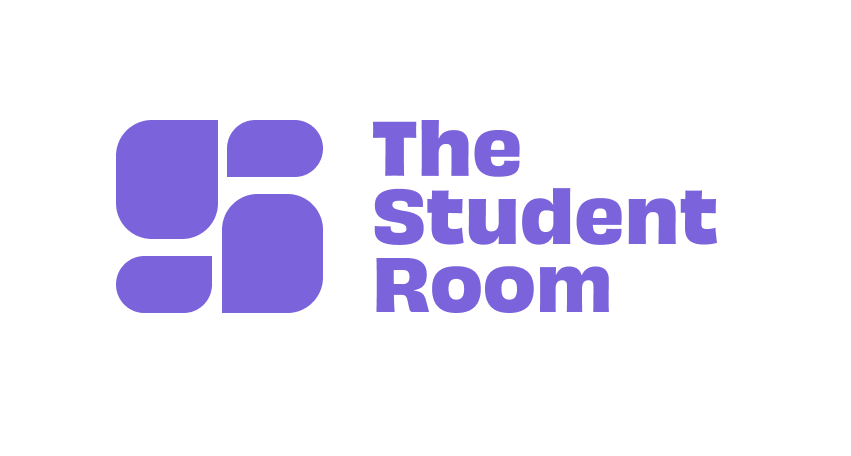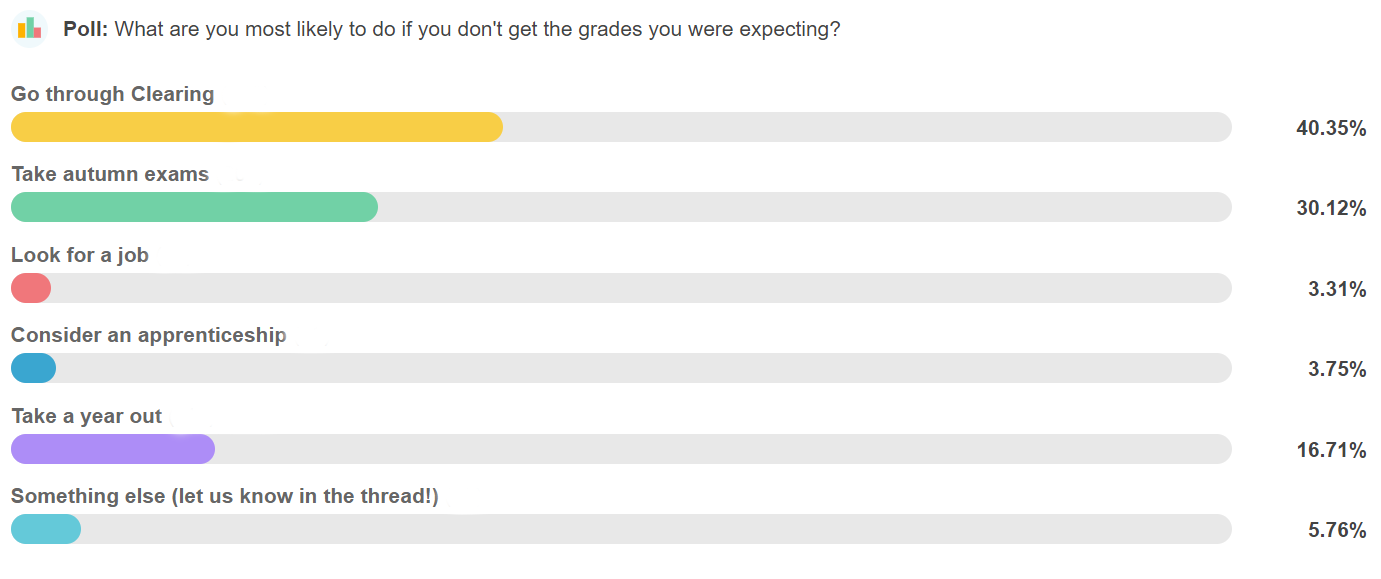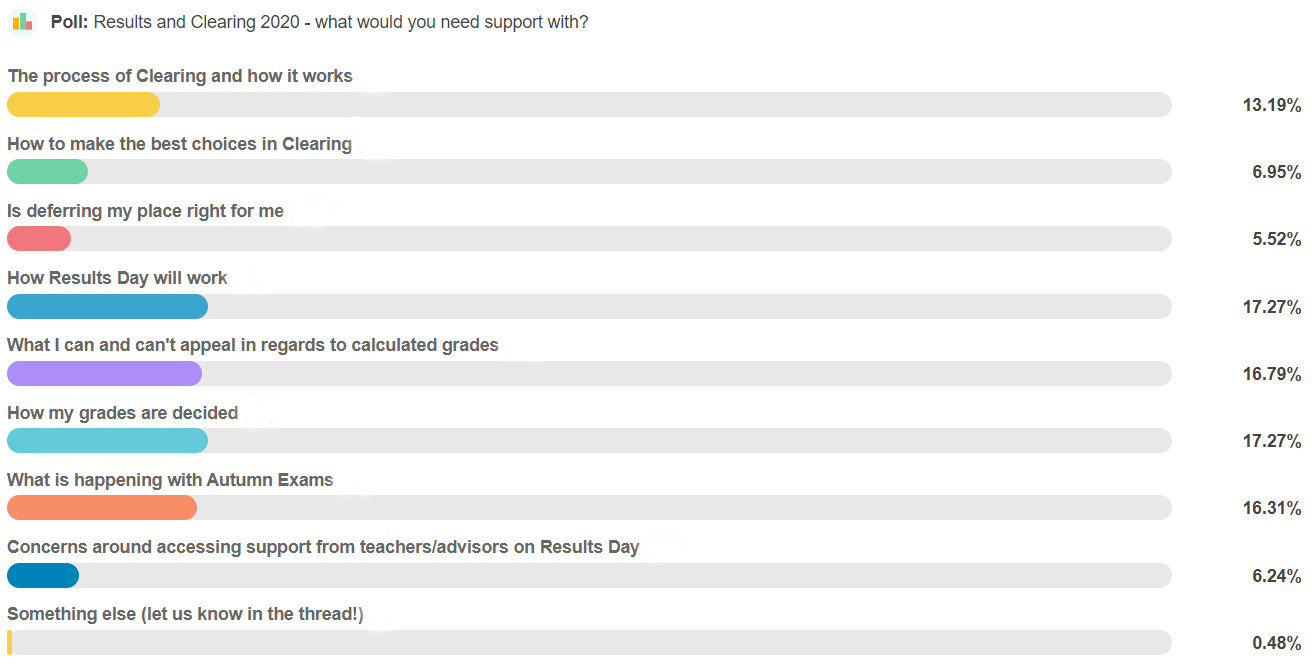With continued uncertainty around grading this summer, Clearing 2021 could be the biggest we’ve seen. In this blog, we’ll look at a mixture of quantitative student data (polls, market research and onsite behaviour) and qualitative data (student comments) to give you a holistic view of what to expect this year.
We’ll also include key brand building strategies based on these learnings to help your university prepare for a successful Clearing cycle.
Half of students still don’t know how they are being assessed
We started polling students a week ago (mid-March 2021) and 52.75% of respondents have said that their teachers have not told them how their grades will be determined this summer:
Teachers have a difficult job on their hands again this year, and we suspect this lack of communication might be because some teachers are under pressure and unsure themselves about exactly what the plans are.
It’s also clear from student comments that there will not be one consistent approach to grading across UK schools:
“They’ve said they’ll go off mock grades, in class assessments and coursework.”
“in my skl they have this thing called portfolio after every lesson”
“My teachers have not said anything they are not helping us in any shape or form besides giving us the wrong things to revise”
“in one subject I will have to sit mini versions of all three papers but I don’t know about the others….another teacher is planning to give us essays to do in class not under timed conditions…How these assessments affect my grades I don’t know”
Some students were concerned about cheating if grades are based on mocks:
“they are going to use past mock grades, which I don’t really approve of…I would have tried a lot harder to ace those mocks if I knew they would have actually meant something. And I know of plenty who cheated in their mocks.”
If there is perceived unfairness in results, or if grade inflation increases competition for university places, we might see more students entering Clearing to secure places at their preferred institutions.
What do we know from the 2020 Clearing cycle?
In 2020, 70,4901 students enrolled through Clearing. The Student Room was keen to understand the reasons that students were choosing the Clearing and Adjustment route, both before and after the event, so we did our own research.
We polled students back in August 2020, and we found that over 40% of respondents were planning to go through Clearing if they did not get the grades they were expecting:
“I’ve already drafted up a bit of a list of unis in clearing who are offering my course…I don’t really want to be waiting around for a year when I can just go off to uni in September”
“The decision to offer exams in October is totally pointless. By the time results will be received most of the first semester will have taken place and it will be too late to start university this year.”
“if I dont get the grades I need I will probably go into clearing and see if there are any other courses I’m interested in”
In October, our market research team (TSR Insight) followed up with an in-depth fieldwork report (Navigating Changing Options, Wave 3)2 about the impact Covid-19 had on the Clearing 2020 cycle.
First-year university students were asked:
What is the main reason you applied through Clearing or Adjustment?
- 39% “Missed my grades for my Firm and/or Insurance choice institutions”
- 19% “Changed my mind about the subject I wanted to study”
- 18% “Changed my mind about the university I had initially chosen”
- 11% “Applied first time through clearing/adjustment”
- 5% “Received better grades than expected”
- 9% “Other”
The fact that such a high proportion of respondents (around 40%) changed their mind about their university or course is a powerful signal to universities that it’s vital to focus on applicant retention.
The 2020 NCO report2 also showed how important it is for universities to raise their profile ahead of Results Day to attract applicants in Clearing. 93% of respondents had existing awareness of the university they chose in Clearing – they had either heard of the university, considered applying there, or had applied to that institution as one of their top five choices (41%). Data from the 2019 cycle showed that only two-thirds of those who enrolled through Clearing had existing knowledge of the university.
This research reinforces that brand building, value-alignment, and ongoing engagement are essential for both retention and acquisition. Deepen relationships with your applicants by thinking about your USPs and why your applicants consider you in the first place. We have found that focusing on shared values, emotions and experiences creates positive associations in the minds of applicants.

Onsite trends – how applicants behave on The Student Room
In 2020, we sent you daily emails around Results week covering student sentiment and onsite behaviour (if you want to refresh your memory, these insights are available here).
Posting was up 78% year-on-year on A-Level results day 2020, but student sentiment was down 27% and posts about anxiety or appealing grades were high. Our sentiment score measures the ratio of happy vs sad emojis in user posts – this gives us an objective metric to track trends in how students are feeling.
Many of us would rather forget Ofqual’s ill-fated algorithm, but last year this had a big impact on our users – many of whom were delayed in entering Clearing as they tried to appeal unrepresentative grades.
This year teachers will be assessing the grades, but uncertainty remains for students so they will need support from universities.
Last year, we asked 2020 Clearing applicants what they might need support with, and many of these areas will also be relevant to the 2021 cycle.
The top concerns were: how Results Day would work (17.27%), how grades would be decided (17.27%), what they could/could not appeal in regards to their grades (16.79%), what was happening about autumn exams (16.31%), and how the Clearing process works (13.19%).
This year we are already seeing plenty of Clearing-related activity. Since the 1st January 2021, our A-Levels forum has had over 1.5m page views, while in the past month our Applications, Clearing and UCAS forum has received 324,136 pageviews, our Coronavirus: impact on schools and exams forum has had 4,437 posts, and we’ve seen 10% growth in Year 13 active members.3
Top tips for Clearing creatives in 2021
In our ‘How to make your clearing creative not suck’ webinar on 24 February, we looked at trends across the top-performing campaigns from 2020. Here are some quick tips for your 2021 creative:
- Start brand building early to build a sense of familiarity (make sure your logo and/or institution name is always visible in every frame or creative)
- Use these colours in display campaigns:

- Use concise, simple, emotive language e.g. “here for you”, “dream big” and “make a difference”
- Use plenty of clickable images in email campaigns
- Make sure your creative is fit-for-purpose:
- Check you can read the copy whatever the device or ad size (think mobile first)
- Design differently for email and display (see our optimisation tips)
- Split-test subject lines and plan your CTAs carefully

For support with your Clearing campaign, get in touch with our team:
0800 999 3222
hello@thestudentroom.com
Data sources
1 UCAS data
2 Navigating Changing Options report: “The experiences of new and continuing university students during Covid-19″
(Clearing and Adjustment, Wave 3 – Fieldwork October 2020)
3 Google analytics, The Student Room, 20 Feb 2021 – 21 Mar 2021





